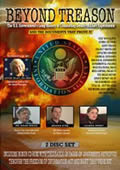PART 2 of 3
By
Marilyn M. Barnewall
October 31, 2010
NewsWithViews.com
How did mortgage fraud of such national proportion happen – and why?
It was the early 1990s, after the U.S. Congress passed the Depository Institutions Deregulation and Monetary Control Act that helped America’s former mortgage lenders fail – you remember the savings and loans industry.
The mortgage lenders that replaced savings and loans wanted to evade title costs. They sought ways to bypass state and county registrations that normally identify and assign property title ownership.
There’s more to this story than Freddie and Fannie investing in a company called Mortgage Electronic Registration System (MERS) to speed things up and, for a fee, reduce land title costs. As stated in Part I, mortgage lenders and realtors decided they could profit greatly if a computer system operated a database to track ownership – and, as part of that process, have that computer system become the “mortgagee of record.” Foreclosure by proxy was born.
Why did it take so long to uncover all of this foreclosure corruption and fraud? Why did it take so long for us to hear the words ‘Mortgage Electronic Registration System’ (MERS)? Why did it take an entire industry so long to ask “Is securitization by proxy legal?”
MERS stands behind two or three giant corporate walls and people don’t know how to penetrate those walls to protect their property. They know they can’t afford to stay in court longer than their mortgage bank and possibly several other big, involved corporations with lawyers on staff. Because of the walls of lawyers ready to defend clients against whom it is difficult to prove criminal intent, MERS has successfully foreclosed without even producing original notes. It’s very difficult to defeat a faceless enemy.
To make things worse, under the MERS program almost any “certifying officer” can come to court, claim ownership of a lien, and proceed to foreclose. There are so many “certifying officers” at MERS, the courts have difficulty verifying whether the entity that shows up in court and claims ownership actually owns the lien on the property. Since MERS by-passes filing the actual name of the lien holder in public records, normal research sources are useless. I repeat: The “certifying officers” don’t work for MERS, they are merely registered on the computer system as “certifying officers.” Crazy, I know.
The actual holder of the mortgage (or a certifying officer that isn’t, but wants to become, the legally recognized lien holder) pays a fee and records the mortgage in the name of MERS. And, when asked, MERS forecloses, acting as proxy document custodian for the stated lien holder. But when mortgage loans have been leveraged so many times in the mortgage-backed derivative process, who knows who the actual lien holder is? Often, the courts do not. Even more often, innocent victims cannot fight their way through the mortgage industry’s walls of lawyers to protect themselves against unlawful foreclosure.
It’s important to understand this process because in its custodial/proxy status, MERS has been viewed as an investment trust. It has no customer service personnel. So if you or your lawyer ask MERS about “the trustee” – if it can be identified – you will likely be referred to the legal servicer, who will then direct you or your counsel back to MERS. Non-responsiveness, then, is used as leverage to intimidate and force homeowners out of their property.
This system appears to make the theft of private property acceptable. If it works with mortgages, it can be used for anything – maybe your pension fund. Nothing will be safe from the personal property mafia. Are mortgages merely a test case?
Another Massive Mortgage Fraud? Judge Reverses Himself After Hot Tub Meeting.
An interesting story published on October 9th by Washington Post Staff Writer Tom Jackman illustrates the breadth and depth of another kind of mortgage fraud.
Earlier in the year, District Judge Gerald Bruce Lee dismissed Bank of America as a defendant in a potential Northern Virginia real estate fraud case – and in November 2010, Judge Lee reversed his own decision.
In Virginia, 129 investors filed against Bank of America, and in North Carolina, 285 investors filed. Both filings were about the same fraudulent act – Bank of America, again. All shouted “foul” on lots they said had been over-valued by the appraiser. Here, mortgage fraud becomes an issue of unrealistic, overstated loan appraisals sanctioned – even encouraged – by mortgage lenders.
In 2006, the 414 investors claim they purchased overpriced vacant lots in North Carolina. They didn’t know they were overpriced because appraisals supported the $400,000 price. Appraisal fraud has become another major financial services industry problem. Investors were assured they could buy the lots with no money down, make no payment for two years, and in the meantime flip the properties for certain profit.
I’m not a fan of real estate flipping speculators. This case is a bit different because of the appraisals. Investors say the seller was buying the lots for $150,000, then reselling them for $300,000 or more. It somehow escapes the “victims’” notice that they planned to buy the lots and then do to another buyer what was done to them. Each of us deals with conscience in our own way.
The investors say their loss could not have occurred without the help of, in this case, Bank of America (notice how often that name comes up?). They charge that the seller of the lots and the bank colluded to inflate appraised property values.
“That's where the hot tub comes in,” says the Washington Post, explaining the Judge’s decision to reverse his Decision. “In March 2010, after Lee's ruling, a lawyer in the North Carolina case obtained more than 700 pages of e-mails that hadn't been turned over in the Virginia case.”
The court records say a meeting was held to discuss the issue. The meeting took place in a hot tub so, with everyone presumably naked, no one could wear a wire. The e-mails showed a Bank of America loan officer discussing ‘recovery appraisals’ with the sellers of the property.
After the hot tub meeting, the emails were made available to the Court and Judge Lee reversed his earlier decision. The emails proved the seller, who wanted $380,000 for a lot, got a first appraisal via Bank of America for $210,000, then a second appraisal of $220,000. Suddenly, a third appraisal of $385,000 for the same lot appeared. Investors were unaware of the first two appraisals. After the real estate market tanked in 2008, the lots plunged to a value of $20,000 each.
“Lee also noted that Bank of America had obtained mortgage insurance for the loans, which could have provided the bank with a safety net - except that the insurance company later canceled many of the policies because of ‘misrepresentation’ by the bank,” the Washington Post article said.
Insurance, huh? Hmmmm… does anyone remember AIG? The Washington Post says “the insurance company later canceled many of the policies,” but that case is currently being litigated. It is yet to be decided. Maybe taxpayers will be bailing out another insurance company?
Judge Lee gave the Virginia plaintiffs permission to re-file their case against Bank of America with the new evidence, though he said "the issue of plausibility still remains. What did the bank have to gain by entering into fraudulent loans?"
Banks used to loan their deposits. Today, the concept of fractional reserve banking rules, not deposits. The more a bank loans, the more money it creates to lend. Deduct 10 percent (the reserve) from a loan, and the remainder is new money the bank can loan. A $385,000 loan minus $38,500 (10%) gives the bank $346,500 per loan at the almost zero Federal Reserve rate. Times 414 people borrowing for North Carolina lots, the bank lends $143.5 million at an interest rate of, say, 8 percent. That’s $11.5 million in loan interest per year. If the individual loans are only $150,000, the bank earns only $4.5 million (on $56 million, total). That’s why, Judge Lee.
How will the foreclosure fraud story end?
Many people think those who have faced unlawful foreclosure will get their homes back free and clear. After all, fraud was perpetrated. Though there is no doubt damage has been done to victims of unlawful foreclosures, the owners signed a mortgage loan. The loan is still a valid contract. When one signs a loan document, one is obligated to repay the loan. An unlawful foreclosure proceeding doesn’t change that hard, cold fact. Suing for damages is a different issue – a different lawsuit.
In MERS cases, evidence of the chain of ownership may have been broken. Because of the way property liens were handled, the courts may remove homes from the mortgage loan as collateral. The mortgage lender still has a valid loan, but may have lost the house as loan collateral.
If the home as collateral is removed from the loan, the FDIC’s auditors won’t give the lender much choice. Bank auditors will likely require the mortgage lender to call the loan, demanding payment in full.
Every loan agreement stipulates that lenders can call loans in full if conditions change that increase the lender’s risk. So, a new mortgage will be written and the collateral (the house) will be properly perfected this time. Because property values have fallen so drastically, the homeowner may be required to provide more collateral than just the house. And, if the borrower cannot so provide – it is legitimate grounds for foreclosure by the lender.
| Subscribe to the NewsWithViews Daily News Alerts! |
Could this be a sneaky way for banks to get those loans on which lien ownership cannot be determined because of the MERS and the mortgage-backed, over-leveraged derivatives mess properly re-assigned as collateral on mortgage loans?
For more in-depth information on MERS, written by Christopher Lewis Peterson, Quinney College of Law, University of Utah. For part three click below.
Click here for part -----> 1, 2, 3,
� 2010 Marilyn M. Barnewall - All Rights Reserved
Sign Up For Free E-Mail Alerts
Marilyn MacGruder Barnewall began her career in 1956 as a journalist with the Wyoming Eagle in Cheyenne. During her 20 years (plus) as a banker and bank consultant, she wrote extensively for The American Banker, Bank Marketing Magazine, Trust Marketing Magazine, was U.S. Consulting Editor for Private Banker International (London/Dublin), and other major banking industry publications. She has written seven non-fiction books about banking and taught private banking at Colorado University for the American Bankers Association. She has authored seven banking books, one dog book, and one work of fiction (about banking, of course). She has served on numerous Boards in her community.
Barnewall is the former editor of The National Peace Officer Magazine and as a journalist has written guest editorials for the Denver Post, Rocky Mountain News and Newsweek, among others. On the Internet, she has written for News With Views, World Net Daily, Canada Free Press, Christian Business Daily, Business Reform, and others. She has been quoted in Time, Forbes, Wall Street Journal and other national and international publications. She can be found in Who's Who in America (2005-10), Who's Who of American Women (2006-10), Who's Who in Finance and Business (2006-10), and Who's Who in the World (2008).
Web site: Deleted by Google
E-Mail: marilynmacg@juno.com











 Share
This Article
Share
This Article






